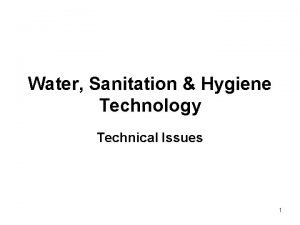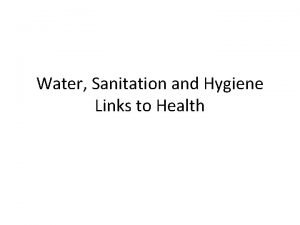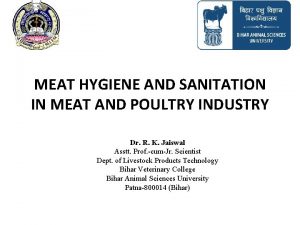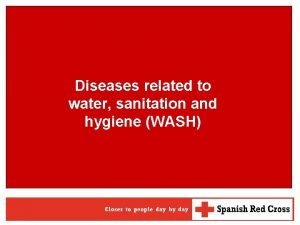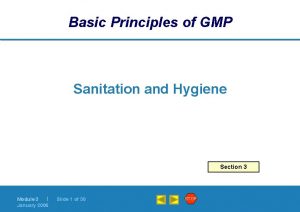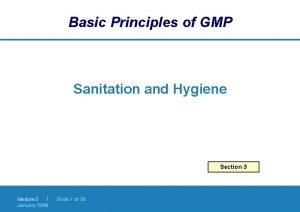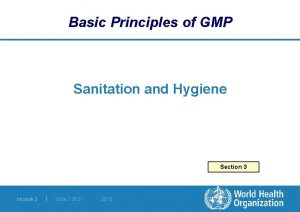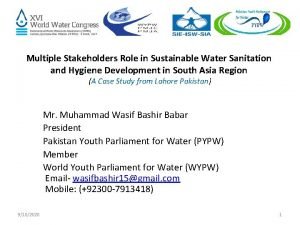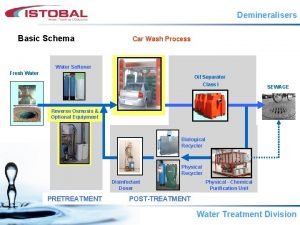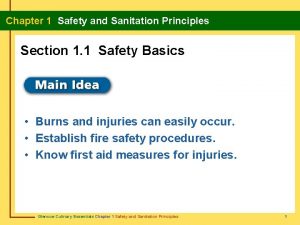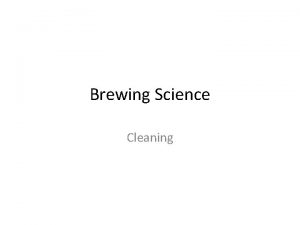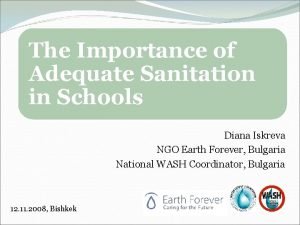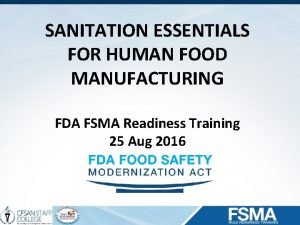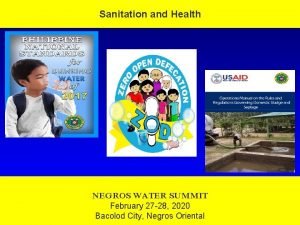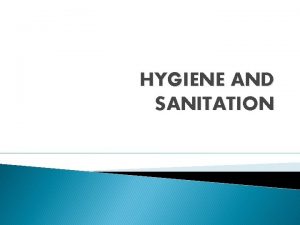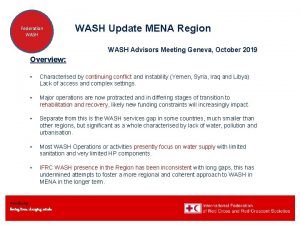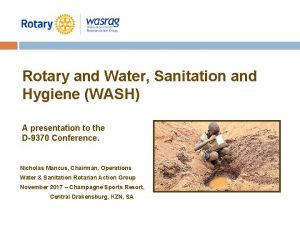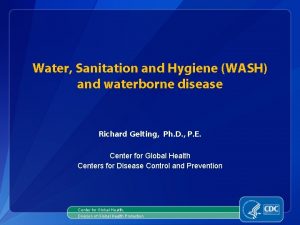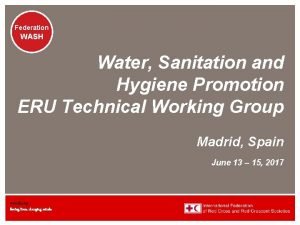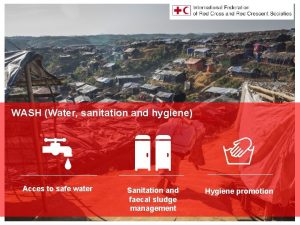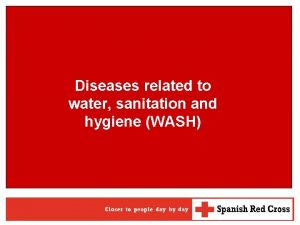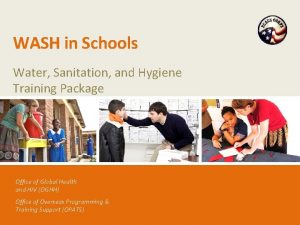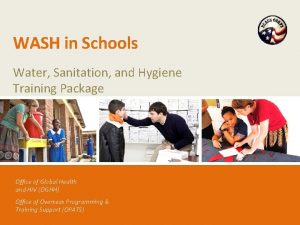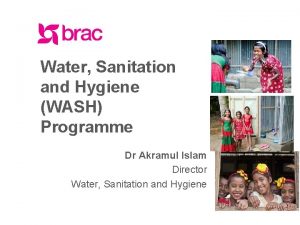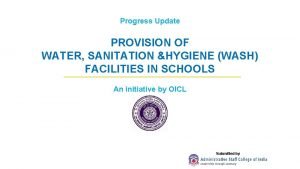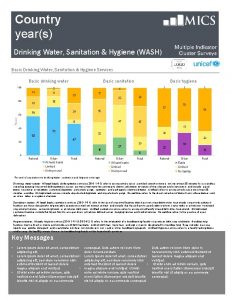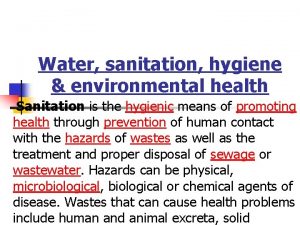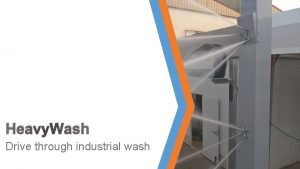Integrated Programming Water Sanitation and Hygiene WASH Session
















- Slides: 16

Integrated Programming Water, Sanitation and Hygiene (WASH)

Session Learning Objectives By the end of this session, participants will be able to: • Describe how WASH and Nutrition are interlinked • Describe how WASH contributes to nutrition outcomes • Identify specific WASH activities that can be integrated into nutrition, health, and FS interventions

What is WASH?

WASH situation in X country • ACCESS TO SAFE WASH – Access to a sufficient quantity of water toimproved be adapted aheadfacilities of training! – Needs Access to sanitation – Access to an improved source of drinking water

WASH response in X country • At household level – Distribution of jerry cans, water filters and consumable hygiene kits for HH with SAM children (NGOs) – Hygiene awareness (NGOs, CVs, CHVs) • At community level Needs to be adapted ahead of training! – Rehabilitation of water schemes in areas with high SAM prevalence & establishment of water management committees (NGOs, GARWSP, contractors) – Demand driven approach to latrine construction and solid waste management in areas with high SAM prevalence (NGOs, CVs, CHVs) – Hygiene promotion / community engagement in areas with high SAM prevalence (NGOs, CVs, CHVs) • At HF level – Ensure WASH facilities in health facilities and treatment centers (coordinated by health cluster but supported by WASH cluster and partners. NGOs, GARWSP, contractors)

WASH’s Impact on Nutrition Mother’s time constraints for fetching water, less time to cook and care for her children

Considerations for Integrating WASH and Nutrition • Strategically contributes to better nutritional (and health) outcomes. • Multiple levels of integration • Goals, capacities and enabling environmentare determinant factors • Positive outcomes of integration outweigh the costs • Gender analysis is crucial; fair recruitment and participation from both men and women

Task: Nutrition and WASH • Discuss the key actions for integration between WASH and your assigned sector, in order to reach nutrition outcomes.

Integration of WASH And Nutrition for Nutrition Outcomes • Target WASH programs in areas of high nutritional need (geographic colocation). • Understand the situation: review existing data, policies and strategies. • Establish and build a working relationship between nutrition and WASH actors. • Engage nutrition and WASH actors in joint program design, planning, implementation, management (interdisciplinary team/steering committee), and consolidated reporting. • Train health and nutrition staff to promote and demonstrate key WASH practices in ongoing nutrition work. • Properly budget WASH staff and activities in nutrition proposals • Do not forget WASH points and sanitation facilities in nutrition centers

Integration of WASH and Health for Nutrition Outcomes • Disease prevalence can guide in the prioritizing of interventions, and might provide hints of what transmission routes can be blocked with WASH interventions. • Preventing WASH related diseases such as diarrhea and malaria will significantly contribute to improved health and nutrition outcomes.

Integrated WASH and FSL Activities for Improved Nutrition Outcomes • Provision of hand washing and toilet facilities in the field and food processing facilities • Behavior change on good hygiene practices around food preparation • Reducing mycotoxins in food through controlled irrigation, moisture control, and through washing • Reducing animal waste contamination

Integrated WASH and FSL Activities for Improved Nutrition Outcomes • Reducing chemical contamination • Ensuring that irrigation runoff is not used for drinking water. • Multiple use water systems • Composting or ecosan for production of fertilizer • Water retention for aquifer recovery – sand dam construction • Erosion control – soil retention & flash flood mitigation • Drip irrigation

Monitoring and Evaluation Domain Indicator Water Proportion of HH’s consistently storing their drinkingwater safety Proportion of HH’s with knowledge of at least one HHWT method Sanitation Proportion of HH’s safely dispensing of children's feces Proportion of HH’s with sanitation facilities that are accessible by children and disabled members of the HH’s Hygiene Proportion of HH’s where primary caregiver can cite critical times for hand washing with soap Proportion of HH’s safely storing children’s food Proportion of HH’s with no visible feces (animal or human) in the compound/yard/ children’s play area

Monitoring and Evaluation Impact Domain Indicator Diarrhea - Outcome Water - Output Increased policy and institutional support for integrating WASH into nutrition programmes - Proportion of children under 2/5 years of age who had diarrhea and diarrhea with blood in the 2 weeks preceding the survey Proportion of children under 2/5 years of age who had diarrhea in the preceding 24 hours Proportion of households with access to an improved water source Proportion of households consistently storing their drinking water safely Proportion of households consistently treating their drinking water with recommended HWT technology Proportion of households with knowledge of at least one HWT method Country has developed a national nutritional plan that includes WASH National WASH plans include explicit targeting of areas with high rates of malnutrition and food insecurity Number of strategies, initiatives and/or partnerships/agreement advocating for integrating WASH and nutrition programmes Proportion of targeted institutions with (increased) expenditures for integrated WASH-nutrition programming

Take Home Messages • WASH plays a critical role in the prevention of diseases and malnutrition. • Target WASH interventions to most malnourished children and communities, ensuring community level linkages • Ensure that WASH and Nutrition interventions use a multiskilled approach to community outreach and community mobilization • Ensure that WASH and Nutrition interventions have harmonised behaviour change messages and approaches • Ensure adequate WASH services at health facilities • WASH is also for food security and livelihoods

Acknowledgements This training package was developed by the Intercluster Nutrition Working Group This training package was funded by This training package was developed with the technical support of
 Sanitation and hygiene
Sanitation and hygiene Sanitation and hygiene
Sanitation and hygiene Poultry hygiene and sanitation
Poultry hygiene and sanitation Sanitation and hygiene
Sanitation and hygiene Gmp sanitation and hygiene
Gmp sanitation and hygiene Gmp sanitation and hygiene
Gmp sanitation and hygiene Gmp sanitation and hygiene
Gmp sanitation and hygiene Water and water and water water
Water and water and water water Stakeholders in water and sanitation
Stakeholders in water and sanitation Car wash water softener
Car wash water softener Chapter 1 safety and sanitation principles
Chapter 1 safety and sanitation principles Cleaning and sanitation manual for breweries
Cleaning and sanitation manual for breweries Compendium of sanitation systems and technologies
Compendium of sanitation systems and technologies Concept school
Concept school Delvic sanitation initiatives
Delvic sanitation initiatives Commercial food sanitation
Commercial food sanitation Environmental sanitation clearance
Environmental sanitation clearance
